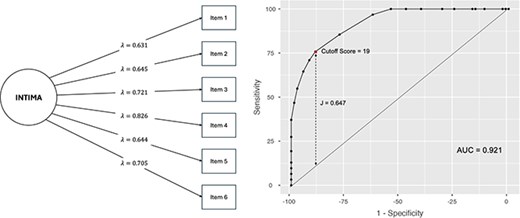-
PDF
- Split View
-
Views
-
Cite
Cite
D Mollaioli, A Sansone, T B Jannini, G Ciocca, E A Jannini, THE INTIMA: DEVELOPMENT AND VALIDATION OF A NEW PSYCHOMETRIC TOOL FOR THE EVALUATION OF PARTNER INVOLVEMENT IN ERECTILE DYSFUNCTION THERAPY AND TO OVERCOME THE “VIAGRA JEALOUSY”, The Journal of Sexual Medicine, Volume 22, Issue Supplement_2, May 2025, qdaf077.072, https://doi.org/10.1093/jsxmed/qdaf077.072
Close - Share Icon Share
Abstract
In the andrological setting, partners play a pivotal role in understanding the causes, risk factors, treatment choices, and may offer support in all the facets of Erectile Dysfunction (ED) management or, vice-versa, may attempt to sabotage the therapeutical output. We thus aimed to study the extent of partner involvement, their psychological attachment pattern, grade of comfort in communicating and sharing ED treatment related information using a new tool, called INTIMA (Impact of Negotiating Treatment Intake on Marital Intimacy/Alliance Assessment).
Amongst the 497 patients enrolled, 134 patients diagnosed with ED following andrological assessment were included in this study. The participants were requested to complete a set of questionnaires including the International Index of Erectile Function (IIEF-15), the INTIMA, the Patient Health Questionnaire (PHQ-9), the Relationship questionnaire (RQ) and the Fear of Intimacy Scale (FIS).
Confirmatory Factor Analysis (CFA) confirmed single-factor structure with optimal goodness indices of fit (chi2 [9] = 11.7, p = 0.234; CFI = 0.991; TLI = 0.985; RMSEA = 0.047; 90% CI [0.00 to 0.104]). In addition, reliability testing using Cronbach’s Alpha (0.84) and McDonald’s Omega coefficients (0.85) showed excellent internal consistency. Convergent and discriminant validity of the INTIMA were confirmed through strong correlations with FIS (r = -0.306 and r = -0.265, p < 0.001) and nonsignificant correlations with PHQ-9 (r = 0.102, p = 0.248), respectively. A high and significant AUC (0.921, p < 0.0001) in discriminating between men with secure and insecure attachment pattern was observed. The ROC curve analysis identified an optimal cut-off score of 19 had 75.81% (95% CI 63.3% - 85.8%) and 88.89% specificity (95% CI 79.3% - 95.1%) with 85.45% positive predictive value (PPV) and 81.01%. negative predictive value (NPV).
Integrating partners during consultations and treatment related deliberations harness a sense of togetherness, support and shared decision making which in turn promises positive treatment outcomes and better sexual life in patients with ED. However, in several couples, sharing the treatments may jeopardize the therapeutical success for a variety of individual and relational reasons. The INTIMA is an easy, simple, and user-friendly tool for measuring the amount of intimacy between partners and their posture with respect of the possible treatments.
None.




